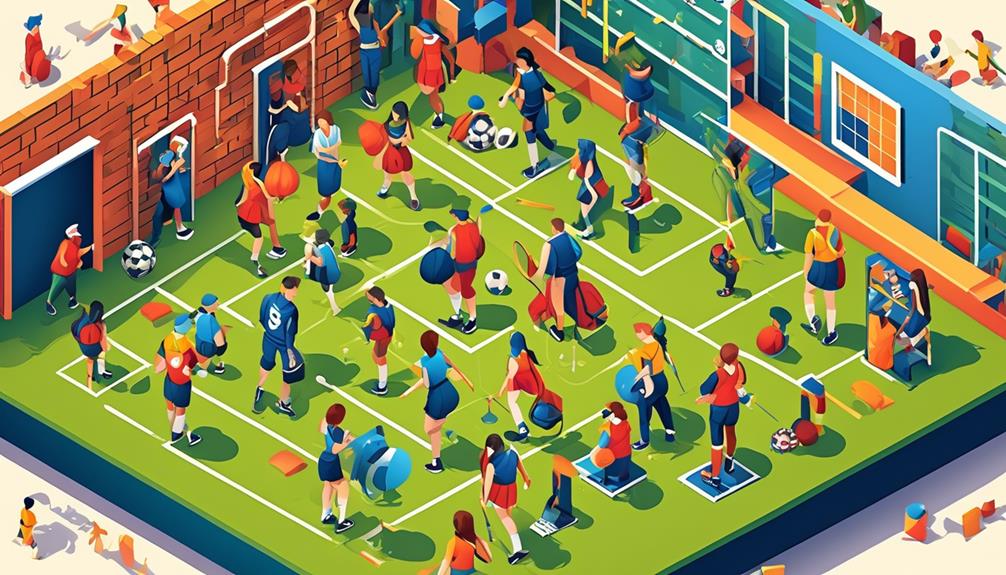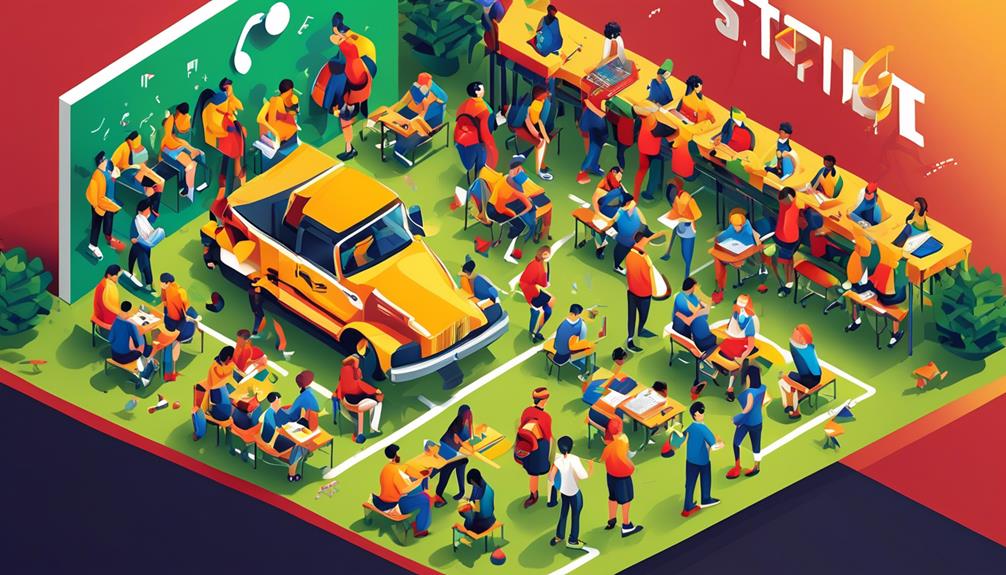Extracurricular activities statistics offer a fascinating glimpse into the diverse interests and engagement levels of today's children. What may surprise many is the significant impact these activities have on various aspects of a child's development. From academic performance to social skills, the data uncovers compelling insights that can shape our understanding of the role of extracurricular activities in shaping young minds.
But what do these statistics reveal about the specific activities children are gravitating towards, and how do they differ across genders and socioeconomic backgrounds?
Key Takeaways
- Participation in extracurricular activities has been increasing in recent years, with children becoming more involved in clubs, sports, and lessons.
- Boys tend to participate more in sports, while girls gravitate towards clubs and lessons.
- Engaging in extracurricular activities enhances academic performance, social skills, and time management abilities.
- Participation in extracurricular activities is associated with future success, as it develops leadership, confidence, resilience, and adaptability skills.
Participation Rates in Extracurricular Activities
In recent years, there's been a notable increase in children's involvement in extracurricular activities, contributing to enhanced academic performance and social skills. This trend is encouraging as it signifies a shift towards a more holistic approach to education.
The statistics reveal that girls tend to participate more in clubs and lessons, while boys are more involved in sports. The fact that 44% of boys and 35% of girls participated in sports in 2020 highlights a gender discrepancy in extracurricular preferences.
Additionally, it's concerning that participation in extracurricular activities decreases across all poverty levels, with children from higher-income households engaging in more activities, particularly sports and lessons. This indicates a potential disparity in access to these enriching opportunities.
While the Survey of Income and Program Participation (SIPP) provides valuable data on children's extracurricular activities, it's important to acknowledge that nonresponse bias and data collection issues may influence the observed patterns.
Lastly, the impact of the COVID-19 pandemic on university students' mental health underscores the significance of extracurricular activities in developing essential skills such as problem-solving, interpersonal, and self-regulatory mechanisms.
Gender Disparities in Activity Preferences

When it comes to extracurricular activities, there are evident gender disparities in preferences. Girls tend to participate more in lessons, clubs, and other non-sports activities, while boys show a higher inclination towards sports.
These disparities raise questions about the underlying reasons and societal influences shaping these activity preferences.
Activity Gender Preferences
Why do girls tend to gravitate towards clubs and lessons while boys are more inclined towards sports? It could be due to a variety of factors, including social expectations, personal interests, and exposure to different activities.
Girls may feel more encouraged to join clubs and take lessons due to societal norms that value cooperative and expressive activities. On the other hand, boys might be drawn to sports as a result of cultural expectations related to physical prowess and competition.
Additionally, individual preferences and experiences play a significant role in shaping activity choices. It's crucial to recognize and respect these differences, ensuring that all children have access to a wide range of extracurricular opportunities that align with their interests and abilities.
Participation Disparity Reasons
Girls' preference for clubs and lessons over sports, compared to boys' inclination towards sports activities, leads to significant gender disparities in extracurricular activity participation. This disparity arises from societal norms and expectations, influencing children's activity choices. The table below illustrates the impact of gender on extracurricular activity preferences.
| Gender | Most Preferred Activities |
|---|---|
| Boys | Sports |
| Girls | Clubs, Lessons |
These preferences contribute to the observed participation gaps, with boys consistently outnumbering girls in sports activities. Addressing this gender disparity requires understanding and challenging societal norms that steer children towards gender-specific activities. By promoting diverse activity options and encouraging individual preferences, we can strive towards more equitable participation in extracurricular pursuits.
Impact of Extracurricular Activities on Academic Performance
Participating in extracurricular activities has been shown to enhance academic performance and social skills in children. As a student, I've experienced firsthand the positive impact of these activities on my learning and personal development.
Here are a few ways extracurricular activities can benefit academic performance:
- Improved time management: Balancing schoolwork with extracurricular commitments teaches students how to prioritize tasks and manage their time effectively.
- Enhanced cognitive skills: Engaging in activities such as music, sports, or debate can stimulate critical thinking, creativity, and problem-solving abilities, which can translate into better academic performance.
- Increased motivation: Pursuing interests outside of the classroom can reignite a passion for learning, leading to improved focus and motivation in academic pursuits.
These benefits highlight the significant role extracurricular activities play in shaping a well-rounded student. By participating in these activities, children not only excel academically but also develop essential life skills that contribute to their overall success.
Relationship Between Extracurricular Activities and Future Success

Experiencing the positive impact of extracurricular activities on my academic performance and personal development has led me to explore the relationship between these activities and future success. As I delve into this topic, I've come across compelling data that highlights the correlation between participation in extracurricular activities and future achievements. Here's a glimpse of some key insights:
| Benefits of Extracurricular Activities |
|---|
| Enhanced Time Management Skills |
| Improved Leadership Abilities |
| Enhanced Social and Emotional Skills |
Engaging in extracurricular activities cultivates essential skills that are invaluable for future success. The ability to manage time effectively, honing leadership qualities, and developing strong social and emotional skills are instrumental in navigating the complexities of the professional world. Furthermore, research indicates that individuals who actively participate in extracurricular activities exhibit higher levels of confidence, resilience, and adaptability, traits that are closely associated with future accomplishments. This data underscores the significance of extracurricular involvement in preparing individuals for the challenges and opportunities that await them.
Benefits of Involvement in Clubs and Lessons

Indisputably, involvement in clubs and lessons has been linked to a myriad of benefits for children, including higher academic performance and improved social skills. As a parent, it's essential to understand the positive impact extracurricular activities can have on our children.
Here are some of the key benefits:
- Boosted Self-Esteem: Through participation in clubs and lessons, children can develop a sense of accomplishment and pride in their abilities, which in turn can boost their self-esteem.
- Enhanced Resiliency: Being part of a club or taking lessons exposes children to challenges and setbacks, teaching them how to overcome obstacles and bounce back from failures.
- Reduced Risky Behaviors: Studies show that children who engage in extracurricular activities are less likely to engage in risky behaviors, as they're occupied with constructive and supervised activities.
Understanding these benefits highlights the importance of encouraging our children to participate in clubs and lessons. It's not just about keeping them busy; it's about providing them with opportunities to grow and develop essential life skills.
Extracurricular Activities and Socioeconomic Factors

As we explore the impact of socioeconomic factors on extracurricular activities, it's crucial to consider how income levels can affect access to various activities.
Additionally, parental involvement plays a significant role in shaping a child's participation in extracurriculars, and understanding these dynamics is essential for addressing equity in activity opportunities.
Income and Activity Access
With a direct correlation between household income and access to extracurricular activities, children from higher-income families tend to have more opportunities to participate in a wider range of activities. This socioeconomic disparity can impact a child's development and future prospects.
The reasons behind this trend are complex and influenced by various factors, including financial resources, parental involvement, and community support. As a result, children from lower-income households may face barriers in accessing enriching extracurricular activities.
The implications of this imbalance are significant, affecting academic performance and social development.
- Financial resources play a crucial role in determining the extent of a child's participation in extracurricular activities.
- Parental involvement and support can greatly impact a child's access to diverse extracurricular opportunities.
- Community resources and infrastructure also contribute to the availability of extracurricular activities for children across different socioeconomic backgrounds.
Parental Involvement Impact
Parental involvement plays a pivotal role in shaping the extracurricular experiences of children, particularly in the context of socioeconomic factors. Research indicates that parents' socioeconomic status significantly influences their children's access to and participation in extracurricular activities.
Higher-income families often have more resources to invest in a wider array of activities, such as music lessons, sports teams, and academic clubs. This increased access can contribute to the development of a diverse skill set and broader experiences for children.
Conversely, children from lower-income families may face barriers to participation, including financial constraints and limited availability of programs in their communities. Therefore, parental involvement, especially in advocating for inclusive and affordable activity options, is crucial in ensuring that children from all socioeconomic backgrounds can reap the numerous benefits associated with extracurricular engagement.
Equity in Activity Participation
Transitioning from the discussion on parental involvement and its impact on extracurricular activities, the disparities in participation based on socioeconomic factors become evident. When it comes to activity participation, there are clear disparities influenced by socioeconomic factors, as highlighted by recent data.
- Gender Disparities: Girls are more involved in lessons and clubs, while boys are more engaged in sports, indicating gender disparities in extracurricular activity preferences.
- Socioeconomic Impact: Children from households with higher financial resources are more likely to participate in activities, highlighting the influence of socioeconomic factors on extracurricular engagement.
- Decline in Club Participation: Club participation declined across all poverty levels, with the most significant decrease seen in children from households below the poverty threshold, indicating potential disparities in access to club-based activities.
These findings shed light on the need for addressing equity in extracurricular activity opportunities.
Trends in Extracurricular Participation Across Age Groups

Participation in extracurricular activities varies across age groups, reflecting distinct trends in engagement and preferences.
According to the Survey of Income and Program Participation (SIPP), children today are involved in more extracurricular activities such as lessons and sports compared to over two decades ago.
Girls tend to participate more in lessons and clubs, while boys are more involved in sports, with an overall increase in sports participation for both genders from 1998 to 2020. However, club participation has decreased among all children during this period.
Interestingly, regardless of the family's income-to-poverty ratio, a decline in club participation was observed. The survey also found that having more financial resources is associated with increased activity participation.
It's worth noting that even during the COVID-19 pandemic, university students managed to engage in extracurricular activities, reaping benefits such as enhanced problem-solving skills, adaptability, and self-regulation.
These trends highlight the evolving landscape of extracurricular engagement across different age groups and provide valuable insights for parents, educators, and policymakers.
Frequently Asked Questions
What Are the Most Common Reasons Why Students Choose Not to Participate in Extracurricular Activities?
I don't participate in extracurricular activities due to lack of interest, heavy workload, financial constraints, time constraints, and social anxiety. These factors hinder my involvement, affecting my decision not to participate.
How Do Extracurricular Activities Vary in Popularity Based on Geographic Location?
In different regions, extracurricular activities vary in popularity due to cultural and social influences. Participation rates and preferences differ based on geographic location, reflecting the diverse interests and opportunities available to students across the country.
Are There Any Specific Extracurricular Activities That Have Been Shown to Have a Negative Impact on Academic Performance?
Excessive sports participation and high levels of clubs and lessons can negatively impact academic performance. It's essential to balance extracurricular activities to avoid strain. The COVID-19 pandemic has also disrupted routines, potentially affecting engagement in these activities.
Do Extracurricular Activities Have Different Effects on Future Success Depending on the Individual's Career Goals or Interests?
Yes, extracurricular activities can have different effects on future success depending on an individual's career goals or interests. The impact varies based on how these activities align with one's aspirations and the skills they develop.
How Do Extracurricular Activities Impact Mental Health and Well-Being, Especially for Students From Lower Socioeconomic Backgrounds?
Participating in extracurricular activities, especially for students from lower socioeconomic backgrounds, can have a significant impact on mental health and well-being. Personally, engaging in clubs and sports provided me with a supportive community and stress relief.
Conclusion
After analyzing the extracurricular activities statistics, I'm astounded by the overwhelming positive impact these activities have on children's development.
The statistics paint a vivid picture of the transformative power of extracurricular activities, from improving academic performance to building social skills.
It's clear that these activities are more than just hobbies – they're essential to shaping well-rounded, successful individuals.










